Wang's Carpets Read online
Page 3
The vote on the microprobes had been close: seventy-two percent in favour, just over the required two-thirds majority, with five percent abstaining. (Citizens created since the arrival at Vega were excluded . . . not that anyone in Carter-Zimmerman would have dreamt of stacking the ballot, perish the thought.) Paolo had been surprised at the narrow margin; he’d yet to hear a single plausible scenario for the microprobes doing harm. He wondered if there was another, unspoken reason which had nothing to do with fears for the Orphean ecology, or hypothetical culture. A wish to prolong the pleasure of unravelling the planet’s mysteries? Paolo had some sympathy with that impulse – but the launch of the microprobes would do nothing to undermine the greater long-term pleasure of watching, and understanding, as Orphean life evolved.
Liesl said forlornly, “Coastline erosion models show that the north-western shore of Lambda is inundated by tsunami every ninety Orphean years, on average.” She offered the data to them; Paolo glanced at it, and it looked convincing – but the point was academic now. “We could have waited.”
Hermann waved his eye-stalks at her. “Beaches covered in fossils, are they?”
“No, but the conditions hardly—”
“No excuses!” He wound his body around a girder, kicking his legs gleefully. Hermann was first-generation, even older than Orlando; he’d been scanned in the twenty-first century, before Carter-Zimmerman existed. Over the centuries, though, he’d wiped most of his episodic memories, and rewritten his personality a dozen times. He’d once told Paolo, “I think of myself as my own great-great-grandson. Death’s not so bad, if you do it incrementally. Ditto for immortality.”
Elena said, “I keep trying to imagine how it will feel if another C-Z clone stumbles on something infinitely better – like aliens with wormhole drives – while we’re back here studying rafts of algae.” The body she wore was more stylized than usual – still humanoid, but sexless, hairless and smooth, the face inexpressive and androgynous.
“If they have wormhole drives, they might visit us. Or share the technology, so we can link up the whole diaspora.”
“If they have wormhole drives, where have they been for the last two thousand years?”
Paolo laughed. “Exactly. But I know what you mean: first alien life . . . and it’s likely to be about as sophisticated as seaweed. It breaks the jinx, though. Seaweed every twenty-seven light-years. Nervous systems every fifty? Intelligence every hundred?” He fell silent, abruptly realizing what she was feeling: electing not to wake again after first life was beginning to seem like the wrong choice, a waste of the opportunities the diaspora had created. Paolo offered her a mind graft expressing empathy and support, but she declined.
She said, “I want sharp borders, right now. I want to deal with this myself.”
“I understand.” He let the partial model of her which he’d acquired as they’d made love fade from his mind. It was non-sapient, and no longer linked to her – but to retain it any longer when she felt this way would have seemed like a transgression. Paolo took the responsibilities of intimacy seriously. His lover before Elena had asked him to erase all his knowledge of her, and he’d more or less complied – the only thing he still knew about her was the fact that she’d made the request.
Hermann announced, “Planetfall!” Paolo glanced at a replay of a scout probe view which showed the first few entry capsules breaking up above the ocean and releasing their microprobes. Nanomachines transformed the ceramic shields (and then themselves) into carbon dioxide and a few simple minerals – nothing the micrometeorites constantly raining down onto Orpheus didn’t contain – before the fragments could strike the water. The microprobes would broadcast nothing; when they’d finished gathering data, they’d float to the surface and modulate their UV reflectivity. It would be up to the scout probes to locate these specks, and read their messages, before they self-destructed as thoroughly as the entry capsules.
Hermann said, “This calls for a celebration. I’m heading for the Heart. Who’ll join me?”
Paolo glanced at Elena. She shook her head. “You go.”
“Are you sure?”
“Yes! Go on.” Her skin had taken on a mirrored sheen; her expressionless face reflected the planet below. “I’m all right. I just want some time to think things through, on my own.”
Hermann coiled around the satellite’s frame, stretching his pale body as he went, gaining segments, gaining legs. “Come on, come on! Karpal? Liesl? Come and celebrate!”
Elena was gone. Liesl made a derisive sound and flapped off into the distance, mocking the environment’s airlessness. Paolo and Karpal watched as Hermann grew longer and faster – and then in a blur of speed and change stretched out to wrap the entire geodesic frame. Paolo demagnetized his feet and moved away, laughing; Karpal did the same.
Then Hermann constricted like a boa, and snapped the whole satellite apart.
They floated for a while, two human-shaped machines and a giant worm in a cloud of spinning metal fragments, an absurd collection of imaginary debris, glinting by the light of the true stars.
The Heart was always crowded, but it was larger than Paolo had seen it – even though Hermann had shrunk back to his original size, so as not to make a scene. The huge muscular chamber arched above them, pulsating wetly in time to the music, as they searched for the perfect location to soak up the atmosphere. Paolo had visited public environments in other polises, back on Earth; many were designed to be nothing more than a perceptual framework for group emotion-sharing. He’d never understood the attraction of becoming intimate with large numbers of strangers. Ancestral social hierarchies might have had their faults – and it was absurd to try to make a virtue of the limitations imposed by minds confined to wetware – but the whole idea of mass telepathy as an end in itself seemed bizarre to Paolo . . . and even old-fashioned, in a way. Humans, clearly, would have benefited from a good strong dose of each other’s inner life, to keep them from slaughtering each other – but any civilized transhuman could respect and value other citizens without the need to have been them, firsthand.
They found a good spot and made some furniture, a table and two chairs – Hermann preferred to stand – and the floor expanded to make room. Paolo looked around, shouting greetings at the people he recognized by sight, but not bothering to check for identity broadcasts from the rest. Chances were he’d met everyone here, but he didn’t want to spend the next hour exchanging pleasantries with casual acquaintances.
Hermann said, “I’ve been monitoring our modest stellar observatory’s data stream – my antidote to Vegan parochialism. Odd things are going on around Sirius. We’re seeing electron-positron annihilation gamma rays, gravity waves . . . and some unexplained hot spots on Sirius B.” He turned to Karpal and asked innocently, “What do you think those robots are up to? There’s a rumour that they’re planning to drag the white dwarf out of orbit, and use it as part of a giant spaceship.”
“I never listen to rumours.” Karpal always presented as a faithful reproduction of his old human-shaped Gleisner body – and his mind, Paolo gathered, always took the form of a physiological model, even though he was five generations removed from flesh. Leaving his people and coming into C-Z must have taken considerable courage; they’d never welcome him back.
Paolo said, “Does it matter what they do? Where they go, how they get there? There’s more than enough room for both of us. Even if they shadowed the diaspora – even if they came to Vega – we could study the Orpheans together, couldn’t we?”
Hermann’s cartoon insect face showed mock alarm, eyes growing wider, and wider apart. “Not if they dragged along a white dwarf! Next thing they’d want to start building a Dyson sphere.” He turned back to Karpal. “You don’t still suffer the urge, do you, for . . . astrophysical engineering?”
“Nothing C-Z’s exploitation of a few megatonnes of Vegan asteroid material hasn’t satisfied.”
Paolo tried to change the subject. “Has anyone heard from Earth, lately? I�
��m beginning to feel unplugged.” His own most recent message was a decade older than the time lag.
Karpal said, “You’re not missing much; all they’re talking about is Orpheus . . . ever since the new lunar observations, the signs of water. They seem more excited by the mere possibility of life than we are by the certainty. And they have very high hopes.”
Paolo laughed. “They do. My Earth-self seems to be counting on the diaspora to find an advanced civilization with the answers to all of transhumanity’s existential problems. I don’t think he’ll get much cosmic guidance from kelp.”
“You know there was a big rise in emigration from C-Z after the launch? Emigration, and suicides.” Hermann had stopped wriggling and gyrating, becoming almost still, a sign of rare seriousness. “I suspect that’s what triggered the astronomy program in the first place. And it seems to have staunched the flow, at least in the short term. Earth C-Z detected water before any clone in the diaspora – and when they hear that we’ve found life, they’ll feel more like collaborators in the discovery because of it.”
Paolo felt a stirring of unease. Emigration and suicides? Was that why Orlando had been so gloomy? After three hundred years of waiting, how high had expectations become?
A buzz of excitement crossed the floor, a sudden shift in the tone of the conversation. Hermann whispered reverently, “First microprobe has surfaced. And the data is coming in now.”
The non-sapient Heart was intelligent enough to guess its patrons’ wishes. Although everyone could tap the library for results, privately, the music cut out and a giant public image of the summary data appeared, high in the chamber. Paolo had to crane his neck to view it, a novel experience.
The microprobe had mapped one of the carpets in high resolution. The image showed the expected rough oblong, some hundred metres wide – but the two-or-three-metre-thick slab of the neutrino tomographs was revealed now as a delicate, convoluted surface – fine as a single layer of skin, but folded into an elaborate space-filling curve. Paolo checked the full data: the topology was strictly planar, despite the pathological appearance. No holes, no joins – just a surface which meandered wildly enough to look ten thousand times thicker from a distance than it really was.
An inset showed the microstructure, at a point which started at the rim of the carpet and then – slowly – moved toward the centre. Paolo stared at the flowing molecular diagram for several seconds before he grasped what it meant.
The carpet was not a colony of single-celled creatures. Nor was it a multi-cellular organism. It was a single molecule, a two-dimensional polymer weighing twenty-five million kilograms. A giant sheet of folded polysaccharide, a complex mesh of interlinked pentose and hexose sugars hung with alkyl and amide side chains. A bit like a plant cell wall – except that this polymer was far stronger than cellulose, and the surface area was twenty orders of magnitude greater.
Karpal said, “I hope those entry capsules were perfectly sterile. Earth bacteria would gorge themselves on this. One big floating carbohydrate dinner, with no defences.”
Hermann thought it over. “Maybe. If they had enzymes capable of breaking off a piece – which I doubt. No chance we’ll find out, though: even if there’d been bacterial spores lingering in the asteroid belt from early human expeditions, every ship in the diaspora was double-checked for contamination en route. We haven’t brought smallpox to the Americas.”
Paolo was still dazed. “But how does it assemble? How does it . . . grow?” Hermann consulted the library and replied, before Paolo could do the same.
“The edge of the carpet catalyzes its own growth. The polymer is irregular, aperiodic – there’s no single component which simply repeats. But there seem to be about twenty thousand basic structural units – twenty thousand different polysaccharide building blocks.” Paolo saw them: long bundles of cross-linked chains running the whole two-hundred-micron thickness of the carpet, each with a roughly square cross-section, bonded at several thousand points to the four neighbouring units. “Even at this depth, the ocean’s full of UV-generated radicals which filter down from the surface. Any structural unit exposed to the water converts those radicals into more polysaccharide – and builds another structural unit.”
Paolo glanced at the library again, for a simulation of the process. Catalytic sites strewn along the sides of each unit trapped the radicals in place, long enough for new bonds to form between them. Some simple sugars were incorporated straight into the polymer as they were created; others were set free to drift in solution for a microsecond or two, until they were needed. At that level, there were only a few basic chemical tricks being used . . . but molecular evolution must have worked its way up from a few small autocatalytic fragments, first formed by chance, to this elaborate system of twenty thousand mutually self-replicating structures. If the “structural units” had floated free in the ocean as independent molecules, the “lifeform” they comprised would have been virtually invisible. By bonding together, though, they became twenty thousand colours in a giant mosaic.
It was astonishing. Paolo hoped Elena was tapping the library, wherever she was. A colony of algae would have been more “advanced” – but this incredible primordial creature revealed infinitely more about the possibilities for the genesis of life. Carbohydrate, here, played every biochemical role: information carrier, enzyme, energy source, structural material. Nothing like it could have survived on Earth, once there were organisms capable of feeding on it – and if there were ever intelligent Orpheans, they’d be unlikely to find any trace of this bizarre ancestor.
Karpal wore a secretive smile.
Paolo said, “What?”
“Wang tiles. The carpets are made out of Wang tiles.”
Hermann beat him to the library, again.
“Wang as in twentieth-century flesh mathematician, Hao Wang. Tiles as in any set of shapes which can cover the plane. Wang tiles are squares with various shaped edges, which have to fit complementary shapes on adjacent squares. You can cover the plane with a set of Wang tiles, as long as you choose the right one every step of the way. Or in the case of the carpets, grow the right one.”
Karpal said, “We should call them Wang’s Carpets, in honour of Hao Wang. After twenty-three hundred years, his mathematics has come to life.”
Paolo liked the idea, but he was doubtful. “We may have trouble getting a two-thirds majority on that. It’s a bit obscure . . .”
Hermann laughed. “Who needs a two-thirds majority? If we want to call them Wang’s Carpets, we can call them Wang’s Carpets. There are ninety-seven languages in current use in C-Z – half of them invented since the polis was founded. I don’t think we’ll be exiled for coining one private name.”
Paolo concurred, slightly embarrassed. The truth was, he’d completely forgotten that Hermann and Karpal weren’t actually speaking Modern Roman.
The three of them instructed their exoselves to consider the name adopted: henceforth, they’d hear “carpet” as “Wang’s Carpet” – but if they used the term with anyone else, the reverse translation would apply.
Paolo sat and drank in the image of the giant alien: the first lifeform encountered by human or transhuman which was not a biological cousin. The death, at last, of the possibility that Earth might be unique.
They hadn’t refuted the anthrocosmologists yet, though. Not quite. If, as the ACs claimed, human consciousness was the seed around which all of space-time had crystallized – if the universe was nothing but the simplest orderly explanation for human thought – then there was, strictly speaking, no need for a single alien to exist, anywhere. But the physics which justified human existence couldn’t help generating a billion other worlds where life could arise. The ACs would be unmoved by Wang’s Carpets; they’d insist that these creatures were physical, if not biological, cousins – merely an unavoidable by-product of anthropogenic, life-enabling physical laws.
The real test wouldn’t come until the diaspora – or the Gleisner robots – finally encountere
d conscious aliens: minds entirely unrelated to humanity, observing and explaining the universe which human thought had supposedly built. Most ACs had come right out and declared such a find impossible; it was the sole falsifiable prediction of their hypothesis. Alien consciousness, as opposed to mere alien life, would always build itself a separate universe – because the chance of two unrelated forms of self-awareness concocting exactly the same physics and the same cosmology was infinitesimal – and any alien biosphere which seemed capable of evolving consciousness would simply never do so.
Paolo glanced at the map of the diaspora, and took heart. Alien life already – and the search had barely started; there were nine hundred and ninety-eight target systems yet to be explored. And even if every one of them proved no more conclusive than Orpheus . . . he was prepared to send clones out further – and prepared to wait. Consciousness had taken far longer to appear on Earth than the quarter-of-a-billion years remaining before Vega left the main sequence – but the whole point of being here, after all, was that Orpheus wasn’t Earth.

 Zendegi
Zendegi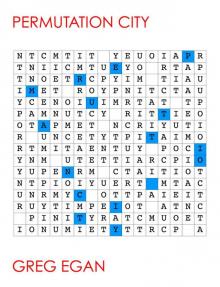 Permutation City
Permutation City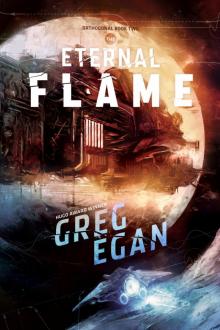 The Eternal Flame
The Eternal Flame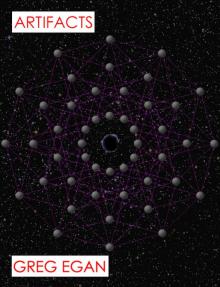 Artifacts
Artifacts Wang's Carpets
Wang's Carpets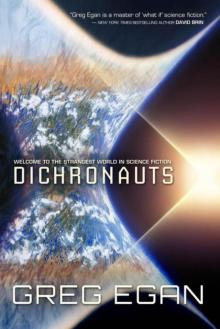 Dichronauts
Dichronauts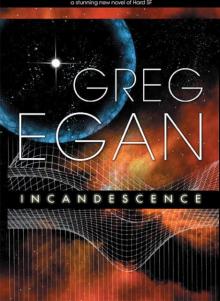 Incandescence
Incandescence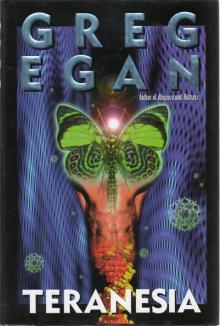 Teranesia
Teranesia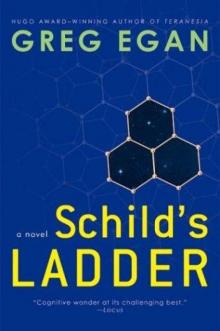 Schild's Ladder
Schild's Ladder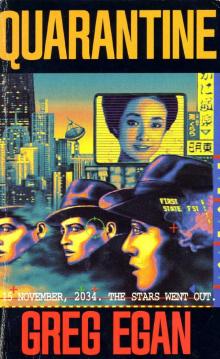 Quarantine
Quarantine The Four Thousand, the Eight Hundred
The Four Thousand, the Eight Hundred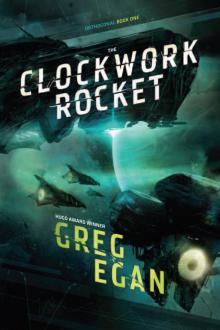 The Clockwork Rocket
The Clockwork Rocket Zeitgeber
Zeitgeber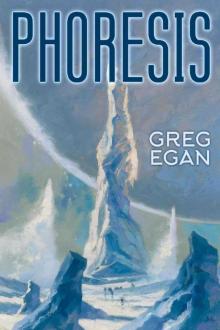 Phoresis
Phoresis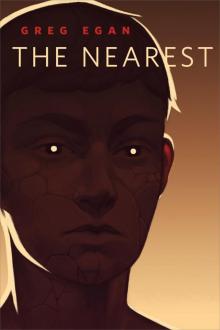 The Nearest
The Nearest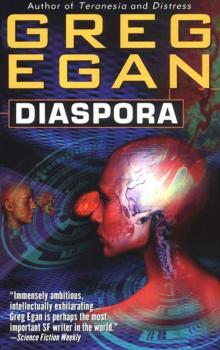 Diaspora
Diaspora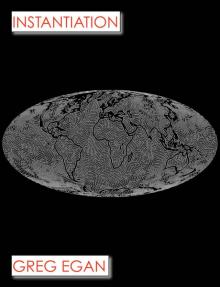 Instantiation
Instantiation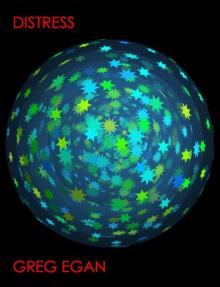 Distress
Distress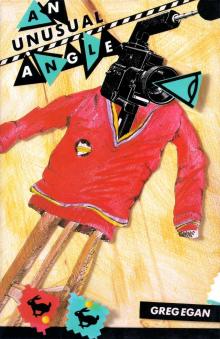 An Unusual Angle
An Unusual Angle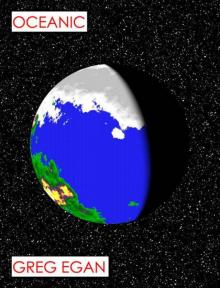 Oceanic
Oceanic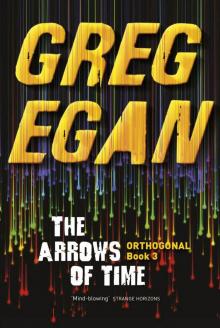 The Arrows of Time
The Arrows of Time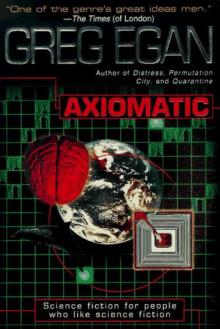 Axiomatic
Axiomatic![Anthology 2. Luminous [1998, 2010] Read online](http://i1.bookreadfree.com/i/03/18/anthology_2_luminous_1998_2010_preview.jpg) Anthology 2. Luminous [1998, 2010]
Anthology 2. Luminous [1998, 2010]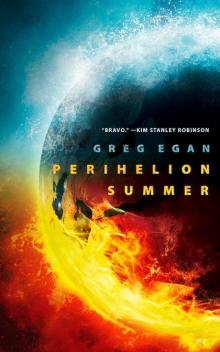 Perihelion Summer
Perihelion Summer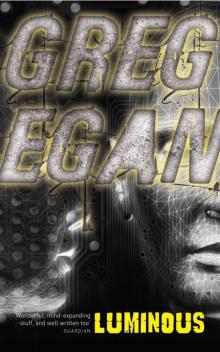 Luminous
Luminous